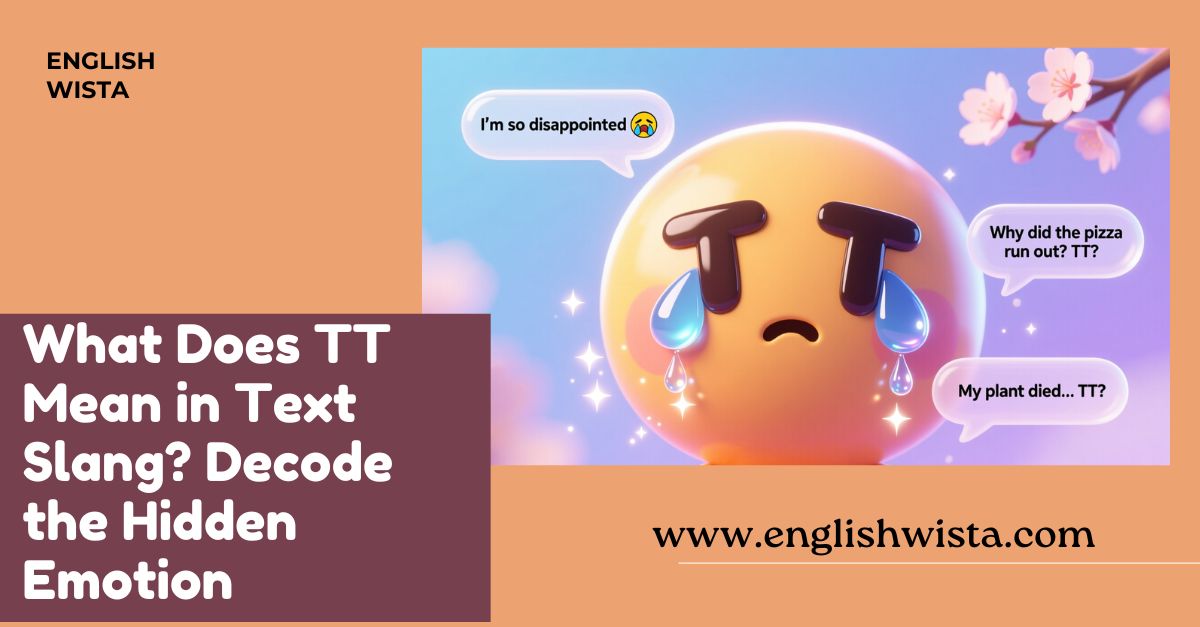If you’ve spent any time texting, scrolling through social media, or chatting online, you’ve probably seen the letters “TT” pop up. But what does it really mean? At first glance, it might seem confusing or like some secret code only a tech-savvy teenager could understand. Don’t worry! by the end of this article, you’ll know exactly what TT stands for, how to use it correctly, and even some fun ways people play around with it online.
Texting and online communication is full of abbreviations, acronyms, and shorthand, and “TT” is one of those little expressions that can mean different things depending on the context. Let’s take a closer look and explore everything you need to know.
What Does TT Mean?
TT is most commonly used to express crying, sadness, or disappointment in text messages and online chats. It’s often seen in informal communication like social media comments, chats on WhatsApp, Discord, or gaming platforms.
The “TT” visually represents tears streaming from eyes. If you imagine two capital “T” letters, each one looks like an eye with a tear falling down:
T T
See? That’s the idea behind TT, it’s like a tiny little crying face made from letters.
Other Meanings of TT
While crying is the most common meaning, TT can have other interpretations depending on the context:
- TT = Texting Talk / Tiny Text
In some rare contexts, TT might be shorthand for “texting talk” or just “tiny text,” though this usage is much less common than the crying version. - TT = Teletype
In technical or older messaging contexts, TT could refer to a “teletype,” a type of communication machine. This is mostly historical, so you won’t see it in everyday texting. - TT = Team Talk / Table Tennis
Among friends or sports enthusiasts, TT could be an abbreviation for “team talk” or “table tennis,” but these are niche uses.
For general texting and online chatting, though, when you see TT, it almost always means crying or being sad.
How to Use TT in Texts
Using TT is pretty simple. It usually appears in messages when you want to show that you’re sad, upset, or touched by something emotional.
Examples in conversation:
- Friend 1: “I just finished the last episode of that show…”
Friend 2: “TT I can’t believe it’s over!” - Friend 1: “I lost my favorite game today.”
Friend 2: “TT that’s so sad 😢” - Friend 1: “I accidentally deleted all my photos.”
Friend 2: “TT nooo!”
Notice how in each case, TT adds an emotional layer, similar to an emoji.
TT vs Other Text Emojis
You might be wondering, “Why not just use 😢 or 😭?” TT works a bit differently:
- TT is text-based: You don’t need a phone or app that supports emojis. Anyone can type it anywhere.
- TT is playful: It gives a cute or exaggerated feeling of sadness, often used humorously.
- TT is versatile: It can represent crying, frustration, or even empathy, depending on the tone of the conversation.
Other common crying abbreviations include:
- T_T: Another variation of TT, representing a more detailed crying face with eyes closed.
- ;_; or ;__;: Represents tears streaming down the face with semicolons as eyes.
Example:
- “I failed my math test TT”
- “I failed my math test T_T”
- “I failed my math test ;_;”
All three convey sadness, but each gives a slightly different emotional effect.
Where Did TT Come From?
TT originated from Asian internet culture, particularly in South Korea, Japan, and China. It became popular in chatrooms, forums, and online gaming communities. The visual representation of tears in the letters made it easy to understand across languages, so it spread widely online.
Interestingly, TT became so popular that it eventually made its way into other countries through K-pop fans, gamers, and social media users. Now, even English speakers frequently use it in texts and online conversations.
How to Recognize When TT is Appropriate
TT is mostly informal, so you’ll usually see it:
- In chats with friends
- On social media posts or comments
- In online forums
- In gaming conversations
It’s not recommended for formal texts, emails, or professional messages. For example, texting your boss “TT I missed the meeting” might not be received well.
Practical Examples of TT in Different Contexts
Let’s explore practical scenarios to help you understand TT better:
1. Sadness or disappointment:
- “TT I can’t come to the party tonight.”
- “My dog is sick TT”
2. Emotional moments:
- “TT that movie made me cry so much.”
- “TT your gift is so thoughtful!”
3. Playful exaggeration:
- “TT I lost my last cookie 😭”
- “TT you beat me again in the game!”
Notice how context affects the tone. TT isn’t always serious—it can be playful too.
Variations of TT
TT has a few popular variations that you might encounter:
- T_T – The classic detailed crying face.
- TT_TT – An even bigger crying effect.
- tT or Tt – Sometimes used to show small, subtle tears.
- TT TT – Repetition for emphasis, often meaning “super sad.”
These variations are mostly about adding intensity or style to the expression.
TT in Pop Culture
TT has also found its way into pop culture, especially K-pop and online fan communities.
- For example, the K-pop group TWICE released a song titled “TT,” where the lyrics use TT to symbolize crying over love and heartbreak. This boosted the abbreviation’s popularity worldwide.
- Memes, GIFs, and reaction videos often use TT to express exaggerated sadness humorously.
So, seeing TT in fan chats or social media comments isn’t unusual, it’s practically a cultural reference at this point!
Fun Facts About TT
Here are some fun little tidbits about TT you might enjoy:
- It’s language-friendly: TT works across different languages because it’s visual. You don’t need to know Korean, English, or Japanese to understand it.
- It predates emojis: TT and similar emoticons existed before smartphones had emojis. People got creative with letters to express feelings.
- TT can be playful or serious: Depending on your tone, TT can be a cute exaggeration or a genuine display of sadness.
Tips for Using TT
- Use it in casual chats: With friends, family, or online communities.
- Pair it with emojis for effect: For example, “TT 😭” can emphasize sadness.
- Avoid in formal communication: TT is informal, so don’t use it in professional emails or serious situations.
- Combine with words for clarity: Sometimes, adding a sentence like “TT I missed it” ensures the other person understands your feeling.
Conclusion
So, what does TT mean in text? At its core, TT is a fun, visual way to show crying, sadness, or disappointment in online chats and messages. It originated from Asian internet culture but has become widely recognized worldwide.
TT can be playful or serious, simple or exaggerated depending on how you write it. It works as a text-based emotional expression, and you’ll often see it alongside other emoticons or words to convey feelings more clearly.
Next time you see TT in a message, you’ll know exactly what it means and maybe you’ll even use it yourself to show a little dramatic sadness or playful crying. Remember, TT is a small but powerful tool in the world of texting, letting you express feelings without typing long explanations.
So, don’t worry if you’ve been confused before, TT is just a little pair of teary eyes saying, “I’m feeling something!”



